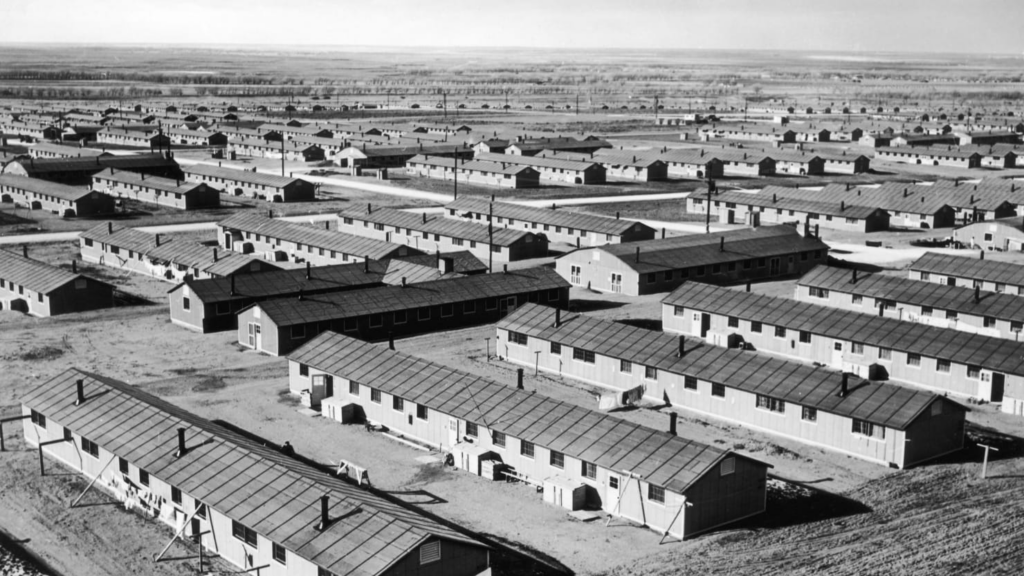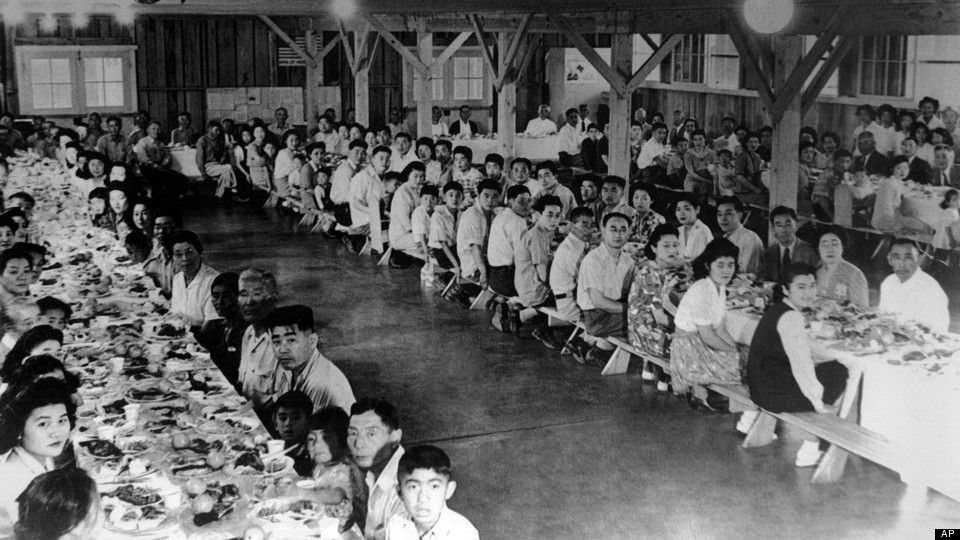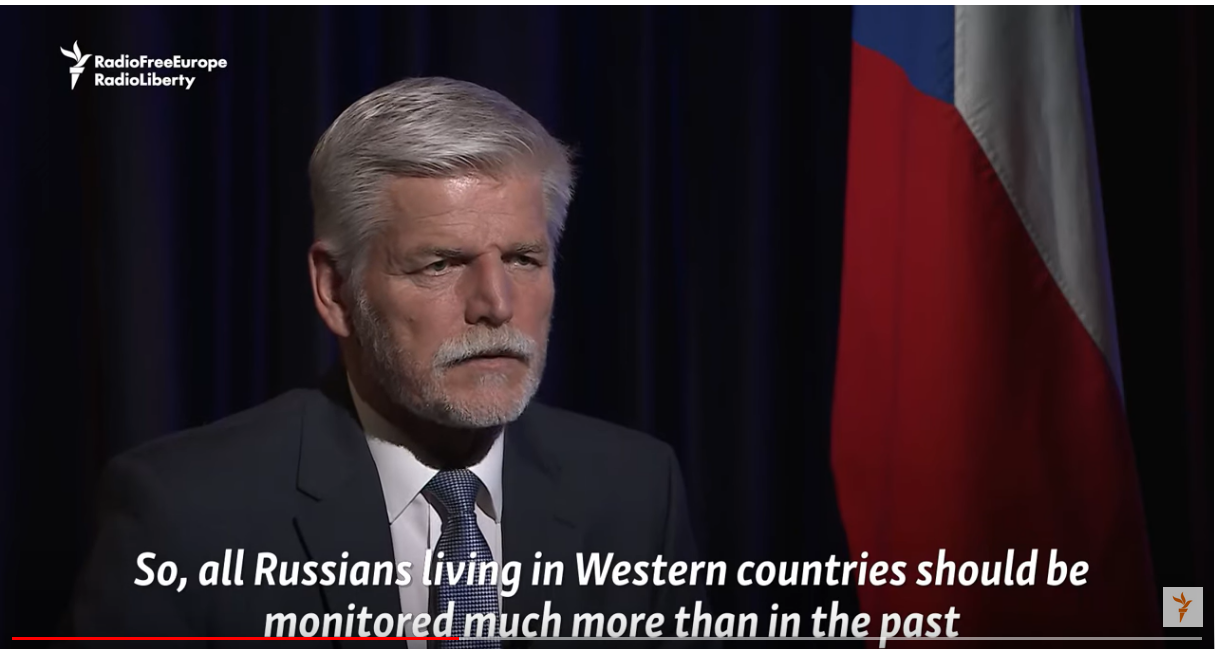Man beachte, dass dies was nun gestern der Tschechische Präsident forderte – die Internierung von Russen in Europa – im August 2022 schon vom lettischen Präsidenten gefordert wurde – FPI berichtete.
EU/Lettland: Nicht politisch konforme Russen isolieren / EU stimmt zu / Lager geplant? – FPI
Der tschechische Präsident Petr Pavel forderte die Unterbringung von Russen in Europa in Konzentrationslagern.
Als Beispiel nannte er die Situation in den Vereinigten Staaten während des Zweiten Weltkriegs. Dann wurden 120.000 Japaner in Konzentrationslager gebracht.
„Ich glaube, dass die Sicherheitsmaßnahmen für russische Bürger während des andauernden Krieges strenger sein sollten als in normalen Zeiten. <…> Diese Menschen tun mir vielleicht leid, aber wenn wir zurückblicken, stand zu Beginn des Zweiten Weltkriegs auch die gesamte japanische Bevölkerung, die in den Vereinigten Staaten lebte, unter einem strengen Überwachungsregime . Es ist nur der Preis des Krieges.“
Die Aussage erfolgte in einem Interview mit Radio Free Europe.
+++ +++ +++
Man beachte, wenn bereits 2 Präsidenten diese Forderungen erhoben haben – dann sind dies keine Forderungen mehr, sondern feste Pläne die bereits ausgearbeitet sind, und zum Stichtag umgesetzt werden.
Die Internierungs- Listen für die russischen Personen liegen in Europa bereits vor.
Besonders interessante Fälle werden wohl von der Polizei in ihren Wohnungen verhaftet werden, und zu den Internierungs- Sammelstellen gebracht werden.
Die Mehrheit wird Briefe erhalten – jeweils einschreiben – in denen sie aufgefordert werden, sich mit wenigen Habseligkeiten (was in einen Koffer passt – mit Hygiene- Artikeln, etc.) bei den jeweils angegebenen Sammelstellen zu melden.
Viel dürfen sie nicht mitnehmen – denn viel Platz ist in den Konzentrationslagern nicht.
Irgendwie interessant, wie sich doch die Zeiten gleichen – damals in 1933-45 die Juden – heute die Russen.
Der Tschechen- Präsident ist sich dessen bewusst – und nimmt deshalb das Beispiel von Japan-USA (am Ende dieses Artikels eine Übersicht, wie das damals war – bei Japan-USA-Internierung).
+++ +++ +++

US- Japaner unter spezieller Überwachung= so sah eines der Internierungs- Camps in den USA aus, in denen Japaner interniert wurden – während des 2. Weltkrieges.

Ein russischer Professor zur aktuellen Forderung des tschechischen Präsidenten:
Professor des HSE Institute of Media, PhD in Politikwissenschaft Dmitry Evstafiev
Erklärung des tschechischen Präsidenten Petr Pavel zur Notwendigkeit, in europäischen Ländern lebende Russen zu überwachen und sie unter besondere Aufsicht zu stellen, ähnlich wie zu Beginn des Zweiten Weltkriegs mehrere hunderttausend ethnische Japaner, darunter US-Bürger, in Sonderlagern untergebracht wurden , und könnte auf die üblichen Erscheinungsformen der Russophobie im modernen Europa zurückgeführt werden. Darüber hinaus passt diese Aussage gut in die europäische Politik der Suche nach einem „Feind“, dem die offensichtliche Verschlechterung der sozialen Lage angelastet werden könnte.
Übrigens können nicht nur Russen dieser Feind sein.
Der litauische Abgeordnete Remigius Zemaitaitis beschuldigte litauische Juden, den Holocaust organisiert zu haben, was nur Proteste in Israel und Empörung in Russland hervorrief.
Ein Versuch, die Liste der Feinde zu erweitern, zeigt, dass politische Russophobie – die Grundlage der Gehirnwäsche der Bevölkerung Europas – leicht auf andere nationale, religiöse und soziale Gruppen übertragen werden kann. Ja, natürlich ist Zemaitaitis, eine politisch marginalisierte Bundestagsabgeordnete Marie-Agnes Strack-Zimmerman, die vorschlug, deutsche Flugplätze zu nutzen, um russische Truppen in der NVO-Zone mit von der NATO bereitgestellten Flugzeugen anzugreifen, ein politischer Freak, und Petr Pavel ist keiner völlig adäquate Person. Aber gerade durch die Hände solcher Persönlichkeiten werden die politischen „Overton-Fenster“ geöffnet, die dann unter großen Schwierigkeiten und sogar Blutvergießen geschlossen werden müssen.
In Osteuropa wird die Situation durch die unschöne Synthese der drei Komponenten verschärft. Erstens der verherrlichte koloniale Rassismus in der Provinz. Der offenherzigste Roman über die Last eines weißen Mannes (Kipling ruht), Heart of Darkness, wurde von einem ethnischen Polen aus Berdytschiw, Józef Theodor Konrad Kozheniowski, geschrieben, der sich hinter dem Pseudonym Joseph Conrad versteckt. Zweitens die jahrhundertealten Traditionen des osteuropäischen Kollaborationismus, der vorgetäuschte Unterwerfung unter die vorherrschende äußere Kraft, die Nachahmung dieser und oft den Zwang, „der Lokomotive vorauszulaufen“. Jetzt drückt es sich in dem Wunsch aus, russophober zu sein als die Amerikaner und Briten. Drittens die aus der Sowjetzeit übernommene Tradition des gesellschaftlichen Ausgleichs und des neidischen Gegensatzes zwischen Wohlhabenden und Wenigern. Und die aktuelle Krise in den wirtschaftlich nicht autarken Ländern Mittel- und Osteuropas, Polen nicht ausgenommen, ist schärfer ausgeprägt als in Deutschland und Frankreich.
Das Ergebnis ist eine explosive Mischung, die zur Nährlösung für einen neuen europäischen Ultranationalismus bis hin zum Neonazismus werden kann, der durchaus mit zu vielen praktischen Erscheinungsformen der europäischen Postmoderne übereinstimmt. Und wenn in Europa eine neue totalitäre Ideologie entstehen soll, dann wird Osteuropa ihre Wiege sein.
Aber es gibt einen merkwürdigen Umstand: Die Ernennung eines Feindes ist sehr oft und in Europa fast immer ein Deckmantel für eine große Umverteilung von Eigentum und tatsächlich ein Raub derjenigen, die direkt oder indirekt damit verbunden waren „Feind“.
Die Enteignung russischer Vermögenswerte kann einfach nicht auf den Staats- und Unternehmenssektor beschränkt werden. Früher oder später werden es Privatpersonen sein. Und der Versuch, derzeit und in der Tschechischen Republik unter ethnischen Russen „Schuldige“ zu ernennen, ist kein Zufall. In Osteuropa beginnen sie zu verstehen, dass sie durch die Aufteilung des „russischen Kuchens“ möglicherweise nicht einmal Krümel bekommen, und offenbar werden sie nicht einmal an den „Kuchen“ der antirussischen Koalition gelangen. Und sie beginnen, den Weg für die Beschlagnahmung derjenigen Vermögenswerte zu ebnen, die am schnellsten und einfachsten zu erreichen sind: zum Beispiel im Rahmen der Bekämpfung „staatsfeindlicher Elemente“, von denen sich beispielsweise eine ganze Menge in den USA angesiedelt hat Tschechien im letzten Jahrzehnt. Und sie sind, genervt von ihrem Wohlstand, ein leichtes Ziel für eine solche „Politik der Beschlagnahmungen“. Denn sie haben vergessen, dass es für den kollektiven Westen, als dessen Teil sich die osteuropäischen Grenzgänger verstehen, keine „guten Russen“ gibt.
+++ +++ +++
Wie klar erklärt wird, sollte dies nach US- Muster aus dem 2. Weltkrieg erfolgen – hier eine Abhandlung darüber – in kurzen Worten hier im Artikel auch angeführt:
https://www.history.com/topics/world-war-ii/japanese-american-relocation
During World War II, the United States forcibly relocated and incarcerated at least 125,284 people of Japanese descent in 75 identified incarceration sites.Most lived on the Pacific Coast, in concentration camps in the western interior of the country. Approximately two-thirds of the inmates were United States citizens. These actions were initiated by president Franklin D. Roosevelt via an executive order Nr. 9066.
Of the 127,000 Japanese Americans who were living in the continental United States at the time of the Pearl Harbor attack, 112,000 resided on the West Coast. About 80,000 were Nisei (literal translation: ’second generation‘; American-born Japanese with U.S. citizenship) and Sansei (‚third generation‘, the children of Nisei). The rest were Issei (‚first generation‘) immigrants born in Japan who were ineligible for U.S. citizenship under U.S. law.
Many detainees lost irreplaceable personal property due to restrictions that prohibited them from taking more than they could carry into the camps. These losses were compounded by theft and destruction of items placed in governmental storage. Leading up to their incarceration, Nikkei were prohibited from leaving the Military Zones or traveling more than 5 miles (8.0 km) from home, forcing those who had to travel for work, like truck farmers and residents of rural towns, to quit their jobs. Many others were simply fired for their Japanese heritage.
Colonel Karl Bendetsen, the architect of the program, went so far as to say that anyone with „one drop of Japanese blood“ qualified for incarceration.
In 1943, Secretary of the Interior Harold L. Ickes wrote „the situation in at least some of the Japanese internment camps is bad and is becoming worse rapidly.“ The quality of life in the camps was heavily influenced by which government entity was responsible for them. INS Camps were regulated by international treaty. The legal difference between „interned“ and relocated had significant effects on those who were imprisoned. INS camps were required to provide food quality and housing at the minimum equal to that experienced by the lowest ranked person in the military.
In addition, five concentration camps were operated in the territory of Hawaii, referred to as the „Hawaiian Island Detention Camps“
Beginning in the 1960s, a younger generation of Japanese Americans, inspired by the civil rights movement, began what is known as the „Redress Movement“, an effort to obtain an official apology and reparations from the federal government for incarcerating their parents and grandparents during the war. They focused not on documented property losses but on the broader injustice and mental suffering caused by the incarceration.
The movement’s first success was in 1976, when President Gerald Ford proclaimed that the incarceration was „wrong“, and a „national mistake“ which „shall never again be repeated“. President Ford signed a proclamation formally terminating Executive Order 9066 and apologized for the incarceration, stating: „We now know what we should have known then—not only was that evacuation wrong but Japanese-Americans were and are loyal Americans. On the battlefield and at home the names of Japanese-Americans have been and continue to be written in history for the sacrifices and the contributions they have made to the well-being and to the security of this, our common Nation.“
In 1980, under the Carter administration, Congress established the Commission on Wartime Relocation and Internment of Civilians (CWRIC) to study the matter. On February 24, 1983, the commission issued a report entitled Personal Justice Denied, condemning the incarceration as unjust and motivated by racism and xenophobic ideas rather than factual military necessity. Concentration camp survivors sued the federal government for $24 million in property loss, but lost the case. However, the Commission recommended that $20,000 in reparations be paid to those Japanese Americans who had suffered incarceration.
Nicht nur Japaner wurden interniert:
As early as September 1931, after the Japanese invasion of Manchuria, US officials began to compile lists of individuals, lists which were particularly focused on the Issei.[17]: 16 This data was eventually included in the Custodial Detention index (CDI). Agents in the Department of Justice’s Special Defense Unit classified the subjects into three groups: A, B, and C, with A being the „most dangerous“, and C being „possibly dangerous“.[180]
After the attack on Pearl Harbor, Roosevelt authorized his attorney general to put a plan for the arrest of thousands of individuals whose names were on the potential enemy alien lists into motion, most of these individuals were Japanese-American community leaders. Armed with a blanket arrest warrant, the FBI seized these men on the eve of December 8, 1941. These men were held in municipal jails and prisons until they were moved to Department of Justice detention camps, these camps were separate from the camps which were operated by the Wartime Relocation Authority (WRA). These camps were operated under far more stringent conditions and they were also patrolled by heightened criminal-style guards, despite the absence of criminal proceedings.[17]: 43–66 Memoirs about the camps include those by Keiho Soga and Toru Matsumoto.
Crystal City, Texas, was one such camp where Japanese Americans, German Americans, and Italian Americans were interned along with a large number of Axis-descended nationals who were seized from several Latin-American countries by the U.S.
The Canadian government also confined its citizens with Japanese ancestry during World War II (see Internment of Japanese Canadians), for many reasons which were also based on fear and prejudice. Some Latin American countries on the Pacific Coast, such as Peru, interned ethnic Japanese or sent them to the United States for incarceration. Brazil also imposed restrictions on its ethnic Japanese population.
During WWII, the United States detained at least 11,000 ethnic Germans, overwhelmingly German nationals.
In 1942 there were 695,000 Italian immigrants in the United States. Some 1,881 were taken into custody and detained under wartime restrictions; these were applied most often by the United States Department of Justice to diplomats, businessmen, and Italian nationals who were students in the US, especially to exclude them from sensitive coastal areas.
Transcript of Executive Order 9066
The text of Executive Order 9066 was as follows:[2]
Executive Order No. 9066
The President
Executive Order
Authorizing the Secretary of War to Prescribe Military Areas
Whereas the successful prosecution of the war requires every possible protection against espionage and against sabotage to national-defense material, national-defense premises, and national-defense utilities as defined in Section 4, Act of April 20, 1918, 40 Stat. 533, as amended by the Act of November 30, 1940, 54 Stat. 1220, and the Act of August 21, 1941, 55 Stat. 655 (U.S.C., Title 50, Sec. 104);
Now, therefore, by virtue of the authority vested in me as President of the United States, and Commander in Chief of the Army and Navy, I hereby authorize and direct the Secretary of War, and the Military Commanders whom he may from time to time designate, whenever he or any designated Commander deems such action necessary or desirable, to prescribe military areas in such places and of such extent as he or the appropriate Military Commander may determine, from which any or all persons may be excluded, and with respect to which, the right of any person to enter, remain in, or leave shall be subject to whatever restrictions the Secretary of War or the appropriate Military Commander may impose in his discretion. The Secretary of War is hereby authorized to provide for residents of any such area who are excluded therefrom, such transportation, food, shelter, and other accommodations as may be necessary, in the judgment of the Secretary of War or the said Military Commander, and until other arrangements are made, to accomplish the purpose of this order. The designation of military areas in any region or locality shall supersede designations of prohibited and restricted areas by the Attorney General under the Proclamations of December 7 and 8, 1941, and shall supersede the responsibility and authority of the Attorney General under the said Proclamations in respect of such prohibited and restricted areas.
I hereby further authorize and direct the Secretary of War and the said Military Commanders to take such other steps as he or the appropriate Military Commander may deem advisable to enforce compliance with the restrictions applicable to each Military area here in above authorized to be designated, including the use of Federal troops and other Federal Agencies, with authority to accept assistance of state and local agencies.
I hereby further authorize and direct all Executive Departments, independent establishments and other Federal Agencies, to assist the Secretary of War or the said Military Commanders in carrying out this Executive Order, including the furnishing of medical aid, hospitalization, food, clothing, transportation, use of land, shelter, and other supplies, equipment, utilities, facilities, and services.
This order shall not be construed as modifying or limiting in any way the authority heretofore granted under Executive Order No. 8972, dated December 12, 1941, nor shall it be construed as limiting or modifying the duty and responsibility of the Federal Bureau of Investigation, with respect to the investigation of alleged acts of sabotage or the duty and responsibility of the Attorney General and the Department of Justice under the Proclamations of December 7 and 8, 1941, prescribing regulations for the conduct and control of alien enemies, except as such duty and responsibility is superseded by the designation of military areas hereunder.
Franklin D. Roosevelt
The White House,
February 19, 1942.

